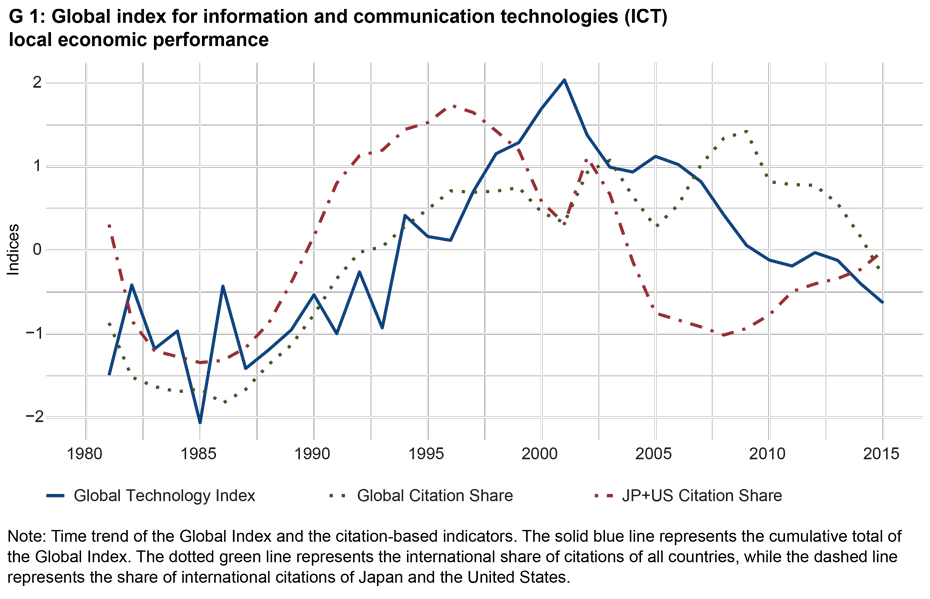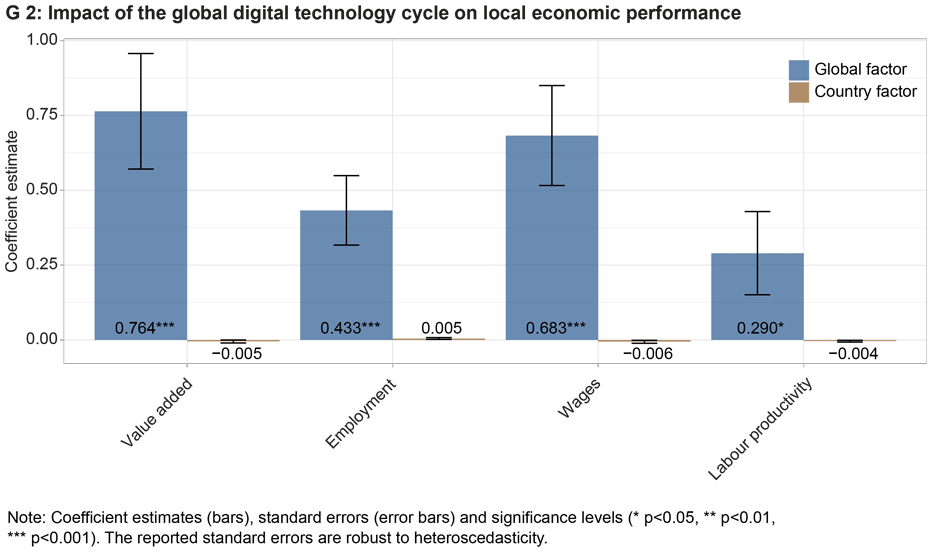
International digital technology cycles and local economic performance
The development of new digital technologies is increasingly dependent on international knowledge. In the recent past this trend has led to political concerns about dependence on foreign knowledge suppliers. A study by KOF, which uses a global patent dataset from 1980 to 2015, emphasises the importance of international knowledge networks for technological progress.
The successful development of new digital technologies such as artificial intelligence, blockchain and the Internet of Things requires access to international knowledge in various digital technology areas. This creates a high level of dependency on knowledge suppliers from abroad. These dependencies have been repeatedly called into question for political reasons in the recent past.
Efforts are being made in many countries to re-nationalise knowledge production in this field, particularly in cross-cutting digital technologies such as cloud computing, big data and machine learning. One example from Switzerland could be the effort to encourage the construction of data centres within the country to ensure that sensitive data obtained from Swiss citizens and companies is stored and processed within the country’s borders.
A KOF Working Paper entitled ‘Global Technology Cycles and Local Economic Performance’ authored by Sebastian Heinrich, Samad Sarferaz and Martin Wörter uses data on the global development of digital technologies to show that an economy’s integration into international knowledge networks is a necessary condition for the economically successful development of new digital technologies.
Global index for ICT and patent citations
The research team has created an index for global technology development in the field of information and communication technology based on a comprehensive global patent dataset from 1980 to 2015. This index provides an in-depth insight into global and specific developments within the technology industry.
Chart G 1 shows the global index for information and communication technologies (ICT) in comparison with international patent citations. Patent citations are references to previous patents as part of new patent applications and can serve as an indicator of the flow of knowledge between countries.
It is clear that past international knowledge flows are strongly linked to current global innovation dynamics through these patent citations. If we move the blue World Index back five years, it fits best with the green line showing all countries. But if we compare the same world index with the United States and Japan (red), we have to go back six years for them to match best. This could mean that the US and Japan are gaining new knowledge faster than other countries.
These empirical insights into the strong link between past knowledge flows and global innovation dynamics establish a close connection to the theory of innovation and economic growth. This forms the basis for interpreting our subsequent analysis of innovation dynamics and economic growth.
International exposure and local economic performance
Chart G 2 shows the impact that the global digital technology cycle (world factor) has on local economic performance. An increase in global activity in the field of digital technology has a positive effect on the growth of the digital sector. For example, a 1 per cent rise in the global index year on year results in a 0.76 per cent growth in value added.
This effect can also be seen in wages and, to a lesser extent, in employment and labour productivity. Interestingly, the country-specific cycles of digital technology (country factors) appear to be less important for growth in the digital technology sector. Rather, it is common global technological advances that boost a country’s digital technology industry and promote its growth.
Further analysis shows that global technology dynamics’ contribution to growth decreases if the global technological exposure of the respective country is relatively high. This could be related to the outflow of knowledge and, consequently, to intensifying global competition – although the net effect remains positive. This contribution and exposure to the global technological cycle thus enhance the performance of the domestic ICT industry.
The reverse mechanism can be observed in the case of domestic dynamics, where the contribution to growth increases with comparatively strong international exposure. This suggests that the domestic ICT industry benefits more from domestic innovation cycles when its exposure to global trends is relatively high. The reason for this positive effect is probably related to knowledge inflows from global technological developments, as researchers observe strong correlations between global dynamics and previous international knowledge flows.
In addition to the above finding, the researchers note that it is not only the relative extent of engagement that matters but also whether global engagement encompasses a broader range of technologies. The findings relating to the breadth of engagement suggest that the ICT industry of a country that is at the global technological forefront in several digital technologies can benefit more from technological synergies than the industry loses from the potential diffusion of its own knowledge.
The US as a positive example of synergies in the technology sector
One striking example of this is the United States, which is a leader in areas such as artificial intelligence, cloud computing, semiconductor technology and quantum computing. Drawing on their broad-based technological expertise, US firms can exploit synergies between these technologies to develop innovative solutions that are competitive in the global market. There are thus advantages for first movers when technological activity is broad-based and the ICT industry makes a substantial contribution to the global technology cycle.
A technologically diverse ICT industry is required in order to properly process the flow of knowledge from abroad and develop internationally competitive technologies in individual digital fields. Products and services based on these more complex technologies, such as autonomous driving, are more difficult to replicate as they require the integration of machine learning, advanced sensor technology and extensive real-time data processing. This creates sustainable competitive advantages and the observed positive relationship between strong exposure to the international technology cycle and the economic performance of the local ICT industry.
Data basis and method
A global patent dataset covering the 35 years between 1980 and 2015 is used as the data basis. Geocoded inventor and applicant data is used to assign country information to the individual patent families. Furthermore, a classification of technological fields is used to delineate detailed ICT (information and communication technology) areas. Annual patent information on 29 countries, which mainly belong to the OECD, is supplemented with four economic indicators: value added, employment, wages, and labour productivity. This data is used to calculate the global technology index and the analysis based on it. The technology index is determined using dynamic factor analysis, a procedure that breaks down the patent dynamics in ICT technologies into global, country-specific and technology-specific effects. This analysis involves identifying common movements, which enables a deeper understanding of the interrelated fluctuations between different data series.
The KOF Working Paper entitled ‘Global Technology Cycles and Local Economic Performance’ by Sebastian Heinrich, Samad Sarferaz and Martin Wörter is available here: external pagehttps://doi.org/10.3929/ethz-b-000611531
Contacts
KOF FB Innovationsökonomik
Leonhardstrasse 21
8092
Zürich
Switzerland
KOF Konjunkturforschungsstelle
Leonhardstrasse 21
8092
Zürich
Switzerland
KOF Konjunkturforschungsstelle
Leonhardstrasse 21
8092
Zürich
Switzerland


